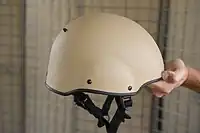Mk 7 helmet
The Mark 7 helmet is a former general issue combat helmet of the British Armed Forces, which was replaced by the Revision Batlskin Cobra Plus as part of the Virtus programme. Officially known as the GS (General Service) Mark 7 combat helmet, it replaced the previous Mark 6A helmet and Mk 6 helmet.
| Mk 7 helmet | |
|---|---|
 A Mark VII combat helmet without camouflage cover. | |
| Type | Combat helmet |
| Place of origin | United Kingdom |
| Service history | |
| In service | June 2009 |
| Used by | See Users |
| Production history | |
| Manufacturer | NP Aerospace |
The helmet is manufactured by NP Aerospace.[1]
History
The Mk 7 helmet was introduced in June 2009 as an Urgent Operational Requirement. It was first shown through the Defence Vehicle Dynamics (DVD) event in Millbrook alongside the Osprey body armour.[2] The British Ministry of Defense announced a purchase of 10,000 sets under initial contracts worth £16 million.[2]
In November 2010, three soldiers from the Royal Irish Regiment credited the helmet for saving their lives when they engaged in a gunfight with Taliban forces.[3] In July 2011, a soldier from the Brigade Reconnaissance Force also credited the helmet from nearly being killed during a gunfight in Helmand province.[4] Defence Science and Technology Laboratory, based in Afghanistan, was asked to assess the damage done to his helmet.[4] Several Mk 7 helmets were donated to the Ukrainian military in 2014.[5]
The Mk 7 helmet was replaced by the Revision Military Batlskin Cobra Plus helmet as part of the Virtus programme.[6]
Design
The Mk 7 offers the same ballistic protection as the Mk 6A, but its new shape allows a soldier to lie flat and shoot straight, without the rear rim digging into the body armour and tipping the front rim over their eyes.[7]
The helmet weights one kilogram (35 oz), significantly less than its 1.5-kilogram (53 oz) predecessor. It also has better chin strapping for stability and is produced in a new colour - tan, unlike the Mk 6A in black and Mk 6 in olive. It's made based on the same ballistic nylon as the Mk 6.[8] The mean penetration velocity (V50) for the Mk 7 it is about 650 metres per second (2,100 ft/s).
This is the velocity at which half (50%) of projectiles are expected to penetrate and is a measure of the helmet's ballistic protection.
Users
 Ukraine: In 2014, the Mk 7 was donated for Ukrainian troops.[9]
Ukraine: In 2014, the Mk 7 was donated for Ukrainian troops.[9] United Kingdom: Issued the Mk 7 together with the Osprey body armor in June 2009.[10]
United Kingdom: Issued the Mk 7 together with the Osprey body armor in June 2009.[10]
References
- Hawser, Anita (15 June 2022). "Armoured to the Teeth – DPI Magazine Article". NP Aerospace. Archived from the original on 13 February 2023. Retrieved 17 February 2023.
- "UK Releases New Helmet and Armor". Soldier Systems. 27 June 2009. Archived from the original on 13 February 2023. Retrieved 17 February 2023.
- "Latest helmet saves soldiers' lives in Afghanistan". Ministry of Defence. 8 November 2010. Archived from the original on 13 February 2023. Retrieved 17 February 2023.
- "Soldier thanks his helmet for lucky escape in Afghanistan". Ministry of Defence. 14 July 2011. Archived from the original on 13 February 2023. Retrieved 17 February 2023.
- "MOD Donnington donates thousands of helmets to Ukraine Military". Ministry of Defence. 1 April 2022. Archived from the original on 13 February 2023. Retrieved 17 February 2023.
- "Revision to Supply State-of-the-Art Cobra Plus Head Protection System for UK Troops". Archived from the original on 26 September 2015. Retrieved 18 September 2015.
- "[ARCHIVED CONTENT] Ministry of Defence - New helmets and armour for troops in Afghanistan". Archived from the original on 1 November 2012. Retrieved 10 November 2010.
- "Mk 7 helmet". Durham City Council. Archived from the original on 13 February 2023. Retrieved 17 February 2023.
- "Army donates thousands of helmets to Ukraine military". The British Army. 31 March 2022. Archived from the original on 12 February 2023. Retrieved 17 February 2023.
- Emery, Daniel (25 June 2009). "UK troops to get new body armour". BBC News. Archived from the original on 25 October 2021. Retrieved 17 February 2023.